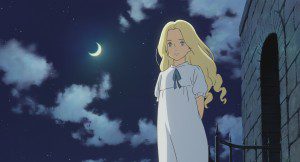Review of When Marnie Was There, Directed by Hiromasa Yonebayashi
Studio Ghibli—the force behind the brilliant animated films My Neighbor Totoro, Spirited Away and The Wind Rises, among many others—returns to movie screens this summer with When Marnie Was There. A new film from Hiromasa Yonebayashi, who directed the studio’s earlier The Secret World of Arrietty (2010), the low-key When Marnie Was There is a gentle, dreamlike picture that makes for pleasant viewing, although it doesn’t linger long after seeing it.
Anna is at the “difficult age” of 12, and that’s not the only difficult thing about her. According to Anna’s mother, the girl has a face that doesn’t show emotion. On top of all that, Anna suffers from asthma.
Anna summarizes her self-loathing succinctly: “I hate myself.”
Sent to live with her aunt and uncle to breathe the clean air in their town, Anna is encouraged to “come back happy” when she returns home.
The film is, to that point, accompanied by melancholy piano music that matches Anna’s mood, but the shift in locale is underscored by a change in the film’s score, which becomes slightly more upbeat thanks to the addition of some softly played guitar. Yet it’s the movie’s beautiful animated imagery that commands attention, including the title character’s flowing blonde hair.

Anna first sees Marnie in the Marsh House—a mysterious but lovely site on the shore near Anna’s uncle and aunt. Anna likes to sit in a boat and draw the Marsh House, which appears to be uninhabited until the lights inside start turning on and off. Through an upstairs window, Anna glimpses an older woman combing a girl’s long blonde hair. The girl, who turns out to be Marnie, has her back turned to Anna, but who is the woman with her?
Anna’s uncle cautions that there are ghosts in the Marsh House—a nearby silo is also said to be haunted—but the introspective Anna isn’t sure what to believe. She desires a friend, and finds one in Marnie. She also befriends a fellow artist who paints and may hold the key to the mysteries surrounding Marnie.
As the two girls spend time together, they draw closer. Both girls are scarred by their pasts, and Marnie’s great gift is getting Anna to confront her inability to forgive those who have hurt and disappointed her.
When Marnie Was There is another thoughtful film brought to U.S. screens by GKIDS, the distributor that earlier brought Hayao Miyazaki’s Studio Ghibli films to American viewers in new prints, and which, in recent years, has distributed Ghibli gems like From Up on Poppy Hill as well as Best Animated Film Oscar nominees A Cat in Paris, Chico and Rita and Song of the Sea. GKIDS furthers its reputation with When Marnie Was There. While not up to the level of Sea or Poppy Hill, Marnie is a welcome respite from the high-octane summer blockbusters and noisy, assertive kids’ movies that have become commonplace among American animated films. Quietly diverting, the film is always beautiful if not as deeply involving as some of GKIDS’ recent releases. Nevertheless, it’s an artful alternative to the largely disposable alternatives clogging the screens during summer movie season.













